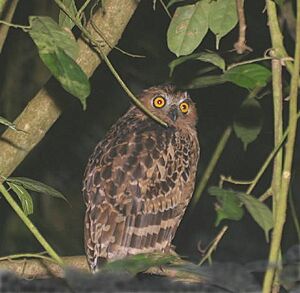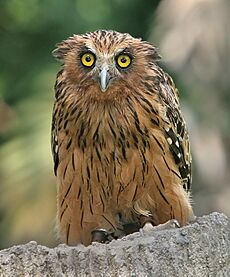Buffy fish owl facts for kids
Quick facts for kids Buffy fish owl |
|
|---|---|
 |
|
| Conservation status | |
| Scientific classification | |
| Genus: |
Ketupa
|
| Species: |
ketupu
|
The buffy fish owl (Ketupa ketupu), also called the Malay fish owl, is a type of fish owl. It belongs to the Strigidae family, which includes most owls. This owl lives in Southeast Asia, mainly in tropical forests and wetlands. Scientists consider its population stable, so it is listed as Least Concern on the IUCN Red List. This means it is not currently in danger of disappearing.
Contents
Understanding the Buffy Fish Owl's Family Tree
Scientists use a system called taxonomy to name and group living things. This helps us understand how different animals are related.
Strix ketupu was the first scientific name given to a buffy fish owl. This happened in 1821 by Thomas Horsfield, who studied an owl from Java. Later, in 1831, René-Primevère Lesson suggested the name Ketupa for fish owls from Java and India.
Over time, scientists found slightly different types of buffy fish owls. These are called subspecies. Today, we recognize three main subspecies of the buffy fish owl:
- K. k. ketupu: Found in places like West Bengal, Assam, southern Thailand, Vietnam, the Malay Peninsula, Sumatra, Java, Bali, and much of Borneo.
- K. k. pageli: Lives in northern Borneo.
- K. k. minor: Found only on Nias island.
Scientists sometimes study the mitochondrial DNA of owls to see how closely they are related. Some have suggested that the Ketupa genus (group) should be combined with the Bubo genus, which includes horned owls. However, other studies show that Ketupa species form their own distinct group.
What Does a Buffy Fish Owl Look Like?
The buffy fish owl is mostly buff brown. It has darker, tawny brown feathers on its back. Its face is lighter, and it has light brown eyebrows. This owl is the smallest of the fish owls. It usually grows to be about 40 to 48 centimeters (16 to 19 inches) tall. It can weigh between 1 and 2.1 kilograms (2.3 to 4.6 pounds).
Like other fish owls, the buffy fish owl has noticeable ear tufts on the sides of its head. Its wing feathers and tail have wide yellow and dark brown stripes. The wings are quite rounded. The feathers on its belly are yellowish-brown with broad black stripes. Its long legs are not covered in feathers.
Fish owls have strong, curved talons (claws). The middle claw has a sharp edge, similar to an eagle's. Unlike many other owls, fish owls do not dive completely underwater to hunt. They prefer to just put their feet into the water. They can also wade into shallow areas.
Most owls have soft feathers that help them fly silently. This allows them to surprise their prey. However, the buffy fish owl's feathers are not as soft. They lack the special fringes that make other owls silent flyers. This means their wing beats make sounds. Also, fish owls do not have a deep "facial disc" like many other owls. This disc helps other owls direct sound to their ears. This suggests that fish owls rely more on their eyesight than hearing when hunting.
Where Do Buffy Fish Owls Live?
The buffy fish owl lives across a wide area. You can find it in Bangladesh, Myanmar, Thailand, Malaysia, Singapore, Cambodia, Laos, Vietnam, and the Sunda Islands. It does not breed on Cocos (Keeling) Island.
These owls live in tropical forests and freshwater wetlands. They like areas near rivers, lakes, and even fish farms. They can be found up to 1,600 meters (5,200 feet) high. They also live in plantations, rural areas, and city gardens.
How Do Buffy Fish Owls Behave?
Buffy fish owls make different sounds. Some sounds include hissing and a fast, rattling kutook repeated about seven times. They also make a loud, ringing pof-pof-pof and a high, hawk-like hie-e-e-e-e-keek sound. Before breeding, they can be quite noisy. Pairs might even sing together for several minutes. During the day, they often rest alone in trees with lots of leaves.
What Do Buffy Fish Owls Eat?
The buffy fish owl mainly eats fish, crabs, frogs, small reptiles, and birds. They also eat dead animals (carrion). Scientists have found many different things in the stomachs of Javan buffy fish owls. These include insects like winged ants and winged termites. They also eat goldfish, gold-ringed cat snakes, young false gharials (a type of crocodile), red junglefowl (wild chickens), black rats, and fruit bats.
They have even been seen eating parts of a crocodile and a Sunda stink badger. Unlike most owls, buffy fish owls do not produce firm pellets of undigested food. Instead, bones and other remains are ejected in pieces. These pieces fall to the ground below where the owl is resting. They hunt mostly from the bank of a river or lake. They swoop down like a fish eagle, but they are careful not to get their feathers wet. They also walk into shallow water to catch food.
How Do Buffy Fish Owls Reproduce?
Buffy fish owls usually lay their eggs from February to April in western Java. In the Malay Peninsula, they lay eggs from September to January. These owls often nest on top of large ferns, like the bird's nest fern (Asplenium nidus). They also use tree holes or forks in branches covered in ferns and moss. Sometimes, they even nest in rocky places, like behind waterfalls.
The nest is usually just a shallow dip in the fern or surface. Owls do not build complex nests. They might also use old nests built by other birds, such as the brahminy kite. Buffy fish owls lay only one egg per breeding season. This is one of the smallest clutch sizes (number of eggs) for any owl. The egg is round, oval, and dull white. On average, eggs in western Java are about 57.4 x 47 millimeters (2.26 x 1.85 inches). The eggs hatch after 28 to 29 days. The young owls are ready to fly after about six weeks.
This owl species is generally doing well. They have even benefited from commercial fisheries and ornamental ponds. They visit these places at night to hunt. Sometimes, pond owners might get upset if the owls take their fish.
What Threats Do Buffy Fish Owls Face?
One of the main threats to buffy fish owls is illegal trade. In 2008, 14 frozen buffy fish owls were found in a storage facility in Johor. They were being illegally sent to China.
In Jakarta, buffy fish owls were sold in bird markets in 2010 and 2012. In 2015, over 300 buffy fish owls were offered for sale online. They were also traded in wildlife markets in other cities like Bandung, Garut, Surabaya, and Denpasar.
How Are Buffy Fish Owls Protected?
In Malaysia, owl species are protected by the Protection of Wild Life Act 1972. They are also listed on CITES Appendix II by the Convention on International Trade in Endangered Species. This means that trading them internationally is controlled to prevent them from becoming endangered. Breaking this law can lead to a fine of 3,000 Malaysian ringgit or two years in jail, or both.
Buffy Fish Owls in Symbols
The Cambodian Special Forces Command Counter-terrorist Group 14 uses the buffy fish owl as their symbol.



